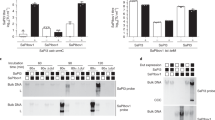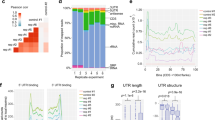Abstract
Staphylococcus aureus is a major human pathogen, the potency of which can be attributed to the regulated expression of an impressive array of virulence determinants. A key pleiotropic transcriptional regulator of these virulence factors is SarA, which is encoded by the sar (staphylococcal accessory regulator) locus1,2,3. SarA was characterized initially as an activator of a second virulence regulatory locus, agr, through its interaction with a series of heptad repeats (AGTTAAG) within the agr promoter4. Subsequent DNA-binding studies have revealed that SarA binds readily to multiple AT-rich sequences of variable lengths4,5,6,7,8,9,10,11. Here we describe the crystal structure of SarA and a SarA–DNA complex at resolutions of 2.50 Å and 2.95 Å, respectively. SarA has a fold consisting of a four-helix core region and ‘inducible regions’ comprising a β-hairpin and a carboxy-terminal loop. On binding DNA, the inducible regions undergo marked conformational changes, becoming part of extended and distorted α-helices, which encase the DNA. SarA recognizes an AT-rich site in which the DNA is highly overwound and adopts a D-DNA-like conformation by indirect readout. These structures thus provide insight into SarA-mediated transcription regulation.
This is a preview of subscription content, access via your institution
Access options
Subscribe to this journal
Receive 51 print issues and online access
$199.00 per year
only $3.90 per issue
Buy this article
- Purchase on Springer Link
- Instant access to full article PDF
Prices may be subject to local taxes which are calculated during checkout





Similar content being viewed by others
References
Projan, S. L. & Novickn, R. P. in Staphylococci in Human Disease (eds Cross, K. B. & Archer, G. L.) 55–81 (Churchill Livingstone, New York, 1997).
Cheung, A. L., Koomey, J. M., Butler, C. A., Projan, S. J. & Fischetti, V. A. Regulation of exoprotein expression in Staphylococcus aureus by a locus (sar) distinct from agr. Proc. Natl Acad. Sci. USA 89, 6462 –6466 (1992).
Cheung, A. L. & Projan, S. J. Cloning and sequencing of sarA of Staphylococcus aureus, a gene required for expression of agr. J. Bacteriol. 176, 4168– 4172 (1994).
Morfeldt, E., Tegmark, K. & Arvidson, S. Transcriptional control of the agr-dependent virulence gene regulator, RNAIII, in Staphylococcus aureus. Mol. Microbiol. 21, 1227–1237 (1996).
Wolz, C. et al. Agr-independent regulation of fibronectin-binding protein(s) by the regulatory locus sar in Staphylococcus aureus. Mol. Microbiol. 36, 230–243 (2000).
Cheung, A. & Ying, P. Regulation of α- and β-hemolysins by the sar locus of Staphylococcus aureus. J. Bacteriol. 176, 580–585 ( 1994).
Blevins, J. S., Gillaspy, A. F., Rechtin, T. M., Hurlbert, B. K. & Smeltzer, M. S. The staphylococcal accessory gene regulator (sar) represses transcription of the Staphylococcus aureus collagen adhesin gene (cna) in an agr-independent manner. Mol. Microbiol. 33, 317– 326 (1999).
Gaskill, M. E. & Khan, S. A. Regulation of the enterotoxin B gene in Staphylococcus aureus. J. Biol. Chem. 263, 6276–6280 (1988).
Manna, A. C., Bayer, M. G. & Cheung, A. L. Transcriptional analysis of different promoters in the sar locus in Staphylococcus aureus. J. Bacteriol. 180, 3828–3836 ( 1998).
Chien, Y.-t., Manna, A., Projan, S. J. & Cheung, A. L. SarA, a global regulator of virulence determinants in Staphylococcus aureus, binds to a conserved motif essential for sar-dependent gene regulation. J. Biol. Chem. 274, 37169–37176 (1999).
Rechtin, T. M. et al. Characterization of the SarA virulence gene regulator of Staphylococcus aureus. Mol. Microbiol. 33, 307–316 (1999).
Holm, L. & Sander, C. Protein structure comparisons by alignment of distance matrices. J. Mol. Biol. 233, 123–138 (1993).
Heinrichs, J. H., Bayer, M. G. & Cheung, A. L. Characterization of the sar locus and its interactions with agr in Staphylococcus aureus. J. Bacteriol. 178, 418–423 (1996).
Lavery, R. & Sklenar, H. J. The definition of generalized helicoidal parameters and of axis curvature for irregular nucleic acids. Biomol. Struct. Dynam. 6, 63–91 (1988).
Saenger, W. Principles of Nucleic Acid Structure (Springer, New York, 1984).
Mahendrasingam, A. et al. Time-resolved X-ray diffraction studies of the B ↔ D structural transition in the DNA double helix. Science 233, 195–197 (1986).
Baxevanis, A. D. & Vinson, C. R. Interactions of coiled coils in transcription factors: where is the specificity? Curr. Opin. Genet. Dev. 3, 278–285 (1993).
Pruss, G. & Drlica, K. DNA supercoiling and prokaryotic transcription. Cell 56, 521– 523 (1989).
Record, M. T. Jr,, Reznikoff, W. S., Craig, M. L., McQuade, K. L. & Schlax, P. J. in Escherichia coli and Salmonella: Cellular and Molecular Biology (eds Neidhardt, F. C. et al.) 792–820 (ASM, Washington DC, 1996).
Oberto, J., Drlica, K. & Rouviere-Yaniv, J. Histones, HMG, HU, IHF: Meme combat. Biochemie 76, 901–908 ( 1994).
Chan, P. F. & Foster, S. J. Role of SarA in virulence determinant production and environmental signal transduction in Staphylococcus aureus . J. Bacteriol. 180, 6232– 6241 (1998).
Hendrickson, W. A. Determination of macromolecular structures from anomalous diffraction of synchrotron radiation. Science 254, 51– 58 (1991).
Collaborative computational project number 4. J. Appl. Crystallogr. D 50, 760 (1994).
Furey, W. B. & Swaminathan, S. PHASE-95: a program package for the processing and analysis of diffraction data from macromolecules. In ;Methods in Enzymol. Vol. 277 (eds Carter, C. W. & Sweet, R. M.) 590–620 (Academic, Orlando, 1997).
Jones, T. A., Zou, J.-Y., Cowan, S. W. & Kjeldgaard, M. Improved methods for building protein models in electron density maps and the location of errors in these models. Acta. Crystallogr. A 47, 110–119 (1991).
Tronrud, D. E., TenEyck, L. F. & Matthews, B. W. An efficient general purpose least-squares refinement program for macromolecular structures. Acta. Crystallogr. A 43, 489–501 (1985).
Laskowski, R. A., MacArthur, M. W. & Thorton, J. M. PROCHECK: a program to check the stereochemical quality of protein structures. J. Appl. Cryst. 26, 283–291 (1993).
Howard, A. J., Nielson, C. & Xuong, N. H. Software for a diffractometer with multiwire area detector. Methods Enzymol. 114, 452– 472 (1985).
Nicholls, A., Sharp, K. & Honig, B. H. Protein folding and association: insights from the interfacial and thermodynamic properties of hydrocarbons. Proteins 11, 281–296 (1991).
Acknowledgements
We thank M. S. Smeltzer for his critical reading of this manuscript. Intensity data collected at the Stanford Synchrotron Radiation Laboratory (SSRL) was carried out under the SSRL biotechnology program, which is supported by the National Institutes of Health (NIH), National Center for Research Resources, Biomedical Technology Program, and by the Department of Energy, Office of Biological and Environmental Research. M.A.S. is a Burroughs Wellcome Career Awardee. This work was supported by the NIH Oregon Health Sciences Foundation (R.G.B.).
Author information
Authors and Affiliations
Corresponding author
Rights and permissions
About this article
Cite this article
Schumacher, M., Hurlburt, B. & Brennan, R. Crystal structures of SarA, a pleiotropic regulator of virulence genes in S. aureus. Nature 409, 215–219 (2001). https://doi.org/10.1038/35051623
Received:
Accepted:
Issue Date:
DOI: https://doi.org/10.1038/35051623
This article is cited by
-
Validation and quality assessment of macromolecular structures using complex network analysis
Scientific Reports (2019)
-
Exploration of Modulated Genetic Circuits Governing Virulence Determinants in Staphylococcus aureus
Indian Journal of Microbiology (2016)
-
Re-visiting protein-centric two-tier classification of existing DNA-protein complexes
BMC Bioinformatics (2012)
-
A structure-based method for identifying DNA-binding proteins and their sites of DNA-interaction
Journal of Structural and Functional Genomics (2005)
-
A structure-based method for identifying DNA-binding proteins and their sites of DNA-interaction
Journal of Structural and Functional Genomics (2004)
Comments
By submitting a comment you agree to abide by our Terms and Community Guidelines. If you find something abusive or that does not comply with our terms or guidelines please flag it as inappropriate.



